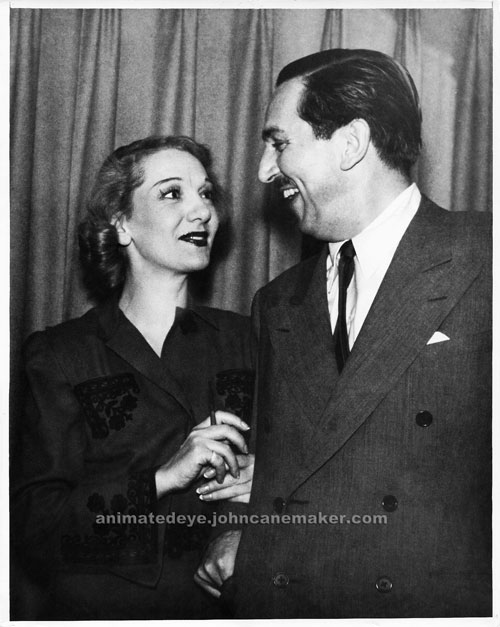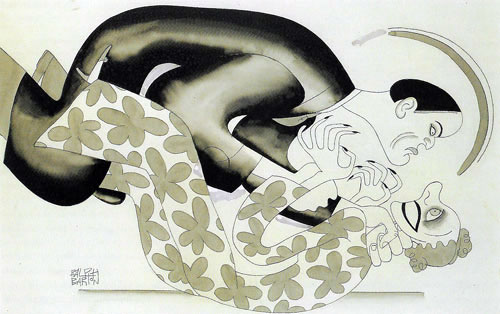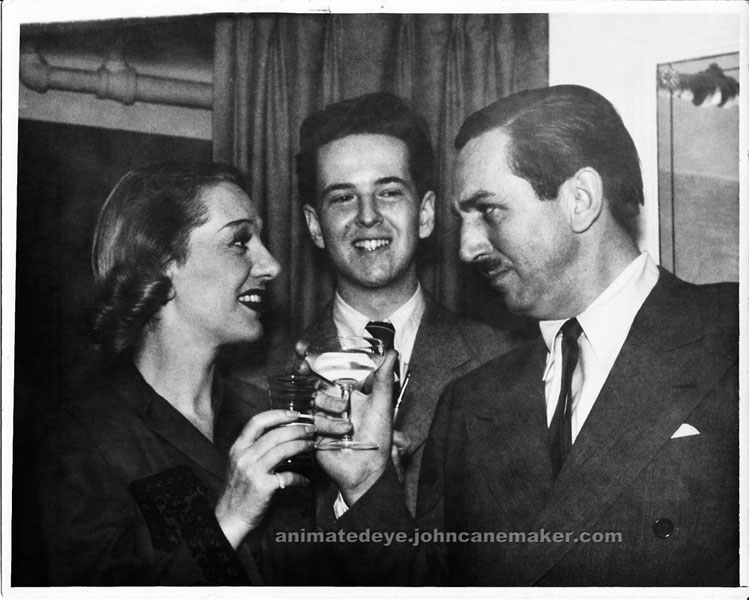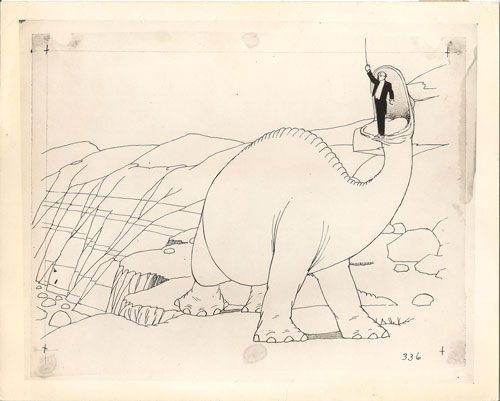
On Saturday, February 7, 1942, Walt Disney attended a performance of the hit Broadway musical Lady in the Dark at the Alvin Theatre, now the Neil Simon Theatre, on West 52nd Street, and went backstage to meet the show’s radiant star, Gertrude Lawrence.
As I noted in my earlier post on The Square World, Disney was facing a difficult period in his career. The attack on Pearl Harbor exactly two months earlier had plunged America into the Second World War and deprived Disney of much-needed revenues from the European and Asian markets. His fifth animated feature, the long-delayed Bambi, had been in pre-production since 1937, at a cost of nearly $2 million, and would not be released until August of 1942.
I asked Michael Barrier, esteemed animation historian and Disney biographer (The Animated Man), why Walt was in New York at that time. “I think the principal reason for Walt’s visit to the East that month,” he replied, “was government business in Washington.” Barrier also noted
[My records] show him arriving in New York from Washington on Thursday, February 5 [1942], and leaving New York for L.A. with a stopover in Kansas City on Wednesday, February 11. He seems to have tacked on visits to New York on a number of occasions when he visited D.C. — no doubt to confer with RKO [his film distributor] people and Kay Kamen [Disney’s merchandising executive], among others . . .
Disney had already cut back significantly on studio staff in early 1941, after the initial box-office disappointments of Pinocchio and Fantasia. Now facing an even greater financial crisis, he wasted no time in seeking war-related projects. Indeed, during the years 1942-1945, the Disney studio would be engaged extensively in making training and propaganda films for the Armed Forces and the home front, and this stream of government work was essential to the studio’s survival.
On this particular day, then, Walt must have looked forward to escaping his mounting worries for a couple of hours with Lady in the Dark, which had been playing to turn-away business for more than a year.

Lady in the Dark opened on Broadway January 23, 1941, and Broadway, frankly, had never seen anything like it — a lavish, innovative musical play about psychoanalysis, written and directed by Moss Hart, with music by Kurt Weill and lyrics by Ira Gershwin, and starring the legendary Gertrude Lawrence.
It was an early concept musical, which abandoned the then-standard Broadway format of chorus lines, love ballads and comic turns. Instead, the narrative integrated a series of dazzling musical “dream” tableaux, each of which revealed a different aspect of the heroine’s psychological state. In abandoning a linear plot for musical vignettes connected by a theme, Lady in the Dark anticipated what would be realized more fully and brilliantly three decades later in the Hal Prince/Stephen Sondheim musicals Company (1970) and Follies (1971).
Lady in the Dark, with a company of 101, massive sets and elaborate costumes, has never been fully revived on Broadway. However, in a 1981 PBS television special, the late Lynn Redgrave accurately recreated Ms. Lawrence’s show-stopping number, “The Saga of Jenny,” with the original staging, and with Danny Kaye, who played The Ringmaster in the 1941 production.

Lady in the Dark opened to superlative reviews. It was the “greatest triumph” of Lawrence’s career, writes Bruce D. McClung, author of a marvelously detailed 2007 book about the show, Lady in the Dark: Biography of a Musical. The New York Herald Tribune called Lawrence “the greatest feminine performer in the theatre.” The New York Times proclaimed her a “goddess.” Another critic hailed her performance as “incredible in its virtuosity.”
A huge hit, the musical often played to standing room only, sometimes 100 standees for each performance. After a summer hiatus (most Broadway shows closed for the summer in those pre-air conditioned days), Lady in the Dark closed on May 30, 1942 after a run of fifty-eight nonconsecutive weeks.
Ms. Lawrence then headlined the show on an eight-city tour, which returned to Broadway for a limited engagement (February thru May 1943), then toured the west coast, finally closing in Los Angeles in July 1943, racking up a grand total of 777 performances.

Gertrude Lawrence (1898-1952), British actress and musical comedy performer, was a legendary star of the West End and Broadway. She is little known today, but earlier generations, who saw her on stage, never forgot her. Though not a conventional beauty, Lawrence possessed, according to her biographer Sheridan Morley, “a radiance which could hold theatre audiences spellbound.”

Her professional relationship with longtime friend Noel Coward, the great playwright/actor, was often tempestuous. But he wrote starring roles for her and himself in Private Lives and Tonight at 8:30.

“Sometimes, in Private Lives,” Coward wrote of his co-star “Gertie,” “I would look at her across the stage and she would simply take my breath away.”
Two photographs taken of Walt meeting Gertie — celebrity to celebrity — are offered here for the first time. In the image at the top of this page, Lawrence is in full stage make-up and dressed in a dark brocaded wrapper. She holds a small eye make-up brush in her right hand and has looped her other hand through Disney’s arm, drawing herself close to him. She smiles warmly, looking up at him, and Walt is literally open-mouthed at his proximity to this glamorous actress.

In the photo directly above, Gertie and Walt toast each other. She, grinning widely, still clutching her make-up brush, hoists an empty water glass; he, a bit more composed, holds a glass of bubble-less “champagne” (probably water), gazes directly into Gertie’s eyes and strikes a dashing Noel Coward-ish pose.
In the middle of that photo, grinning joyfully, is a 17-year old self-taught, would-be animator named Robert N. Brotherton (1925 – 1989). Bob loved Disney films, and it was obviously a great thrill to be so close to his idol, Walt Disney. Brotherton’s father, manager of the Alvin’s box office, arranged for his son to meet Walt.
Bob Brotherton was a sweet, generous man with an innate sense of history and a love for the art of animation. It was Bob who gave me the two original prints of the above photos. And it is appropriate that he shared a photo frame with Walt Disney, since Bob Brotherton also made a very significant contribution, albeit indirectly, to animation history.
Five years after this photo with Disney and Ms. Lawrence was taken, Bob had a fateful encounter with another star performer named Gertie, namely pioneering animator Winsor McCay’s celebrated 1914 animated cartoon dinosaur. For it was Bob who, in 1947, rescued the original 35mm negatives and prints of the films of Winsor McCay, which otherwise would have been lost forever. Not only did he save McCay’s Gertie film, and others, from destruction and oblivion, he also rescued and preserved a goodly number of McCay’s original Gertie animation drawings.

I wrote briefly about Bob and his heroic salvaging efforts in my 1987 biography, Winsor McCay – His Life and Art. But he has never received enough recognition for his extraordinary salvaging and protection of the film legacy of Winsor McCay. Practically nothing has been written about the life of this man who, in his own way, had the passion for film preservation and tenacity of Henri Langlois.
I will rectify that oversight soon, in a future blog posting of John Canemaker’s Animated Eye.
Hits: 84663

A terrific post, John, and I look forward to your follow-up.